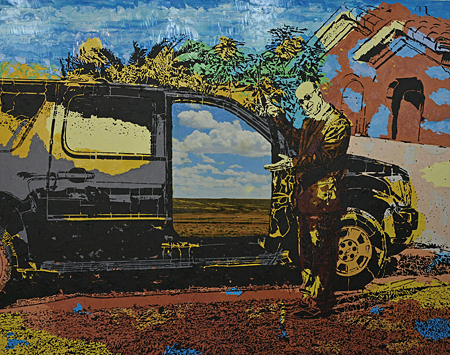
Continuing through November 20, 2016
Though the conceptual techniques of Lucinda Luvaas and Rufus Snoddy differ, each has overtones of social consciousness and each provide insights into their individual ideologies and histories. Though varying in background and experience, both artists tackle visceral relations to their environment.
Coming of age when women artists began to create through a feminist lens, Luvaas was able to sharpen her own artistic proclivities, gender-based or otherwise. As a composer, painter and filmmaker, narrative plays a prominent role in her art. To that end she is aided by an arsenal of media. Through the years she developed an exacting technique called “imprinting,” a hybrid between relief painting and printmaking. Black forms and lines produce the stenciled look of block printing, but surfaces built from gel, wax and pigment add compelling dimensions.
It’s a technique that allows her to produce, with detailed precision, surreal hard-edge visions. In “Birdman,” for example, muted colors and the rigidity of process make an active scene appear suspended in time. Yet when works such as “Passage” are saturated with deep reds, ochre and teal, they add a rhythmic pulse that belies surface rigidity.
Luvaas challenges the viewer to contemplate what is real and what is imagined. This is evident in works such as the Magritte-like vision of “The Great Beyond,” where a car appears to be filled with a landscape. She vacillates between those surreal-like visions and real-life narratives. Focusing on specific moments in time, for instance, she depicts individuals who are actively engaged in activities such as strolling or biking. But it is the social and psychological possibilities of urban environments that offer rich fodder, enabling her to focus on the sense of isolation experienced in crowded cities. Her cinematic impulses come into play in scenes where throngs of people appear frozen in place, as though a film was stopped mid-way through the action.
While Luvaas emphasizes cool alienation through a style that is deliberate and flat, Rufus Snoddy’s mixed media constructions are emotionally charged. To a large measure, he has been inspired by his exposure to both the tumult and congestion of Los Angeles and to the isolated landscapes of Texas and Lake Michigan Bays. Drawing from the experience of navigating both urban and rural terrains as a black man has resulted in intriguing dichotomies in his art. He has also traveled extensively, and the impulses and techniques of diverse cultures echo in his art. Although his psychological and ethnic identifications lead him to draw from design elements found in ceremonial African art and indigenous cultures, he brings his own innovative perspectives.
Snoddy is resistant, however, to having his art viewed through the lens of social consciousness. Although he admits to the influence of artists such as Betye Saar and John Outerbridge, among others, he is reluctant to have his art associated with political movements. References to African masks and shields are clear, but he allows for the creation personal myths and symbolisms to become eminent.
The importance of formal balance and proportion is particularly evident in his “Construction Paintings.” In particular, he expresses the need to metaphorically compare the relationships between textures and finishes to the relationships between the rhythms and patterns between people. It’s a sentiment that can be a stretch for the viewer.
Nature also plays a prominent role. With the inclusion of found and fabricated materials such as string, wax, paper, wood and feathers, the constructions resemble the talismans and textiles of indigenous cultures. The intricate interplay between texture, figure and design create an edgy pull between decorative fields and the strange, otherworldly figures set within them. In fact, works such as “Alien Nation Celebration” and “Behind my Back” could be ritual altars from extraterrestrials. Emotive and powerful, this series of eclectic constructions are mysterious and eccentric.
Though Luvaas’ works are static and Snoddy’s dynamic, the kinship between them is expressed in both their efforts to bring exceptionally quirky visual perspectives to human activities and environments.
Published Courtesy of ArtSceneCal ©2016
